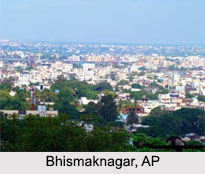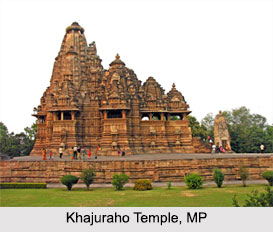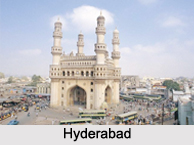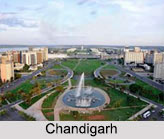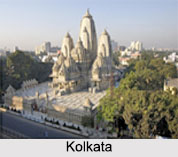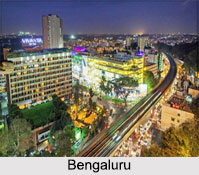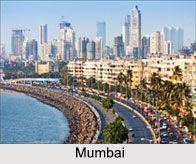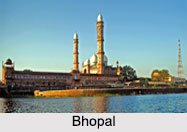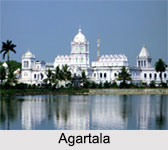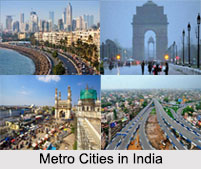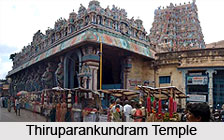 The visitors can roam around various beautiful places surrounding Madurai. Some of these places are given here:
The visitors can roam around various beautiful places surrounding Madurai. Some of these places are given here:
Thiruparankundram
Thiruparankundram is one of the abodes of Lord Subramanya. It is situated 8 kms south of Madurai. The six abodes of the deity are known as `Arupadai Veedu`. This is a cave temple. This temple is known from the Sangam times. One of the Sangam poets Nakkiran has sung a long poem about this temple called Thirumurugatrupadai.
In this temple of Thiruparankundram, there are a series of mandapams one above the other in elevation. A shrine dedicated to Nakkirar can be seen here. The marriage of Deivayanai and the sculptures of Thirumalai Nayak and Mangammal can be seen in the front mandapam.
There are caves in the descent from the mandapam. These are filled with images of Annapoorna, Varaha Avataram, Narasimha Avataram, Mahalakshmi etc. One of the masterpiece sculptures of the group is the Sivathandavam in which Uma is witnessing it reclining on the bull. The Kudarmugha drum also can be seen being beaten by a celestial attendant.
Kallazhagar Koil
Kallazhagar Koil is situated 21 kms from Madurai. It is an important Vishnu temple at the foot of a wooded hill. The term `Azhagu` in Tamil means beauty and true to its meaning, everything here is a thing of beauty and a joy forever.
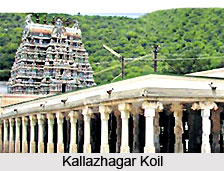 In this Kallazhagar Koil, the main deity is Paramaswami and the itinerant idol is Kallazhagar. This beautiful idol is made of pure gold. Apart from this and another at Thiruvanathapuram, no other temple has an idol made of pure gold. The ablution water for this idol is brought from Noobura Gangai, which is a perennial waterfall 3 kms up on the hill. Its water contains copper and iron minerals.
In this Kallazhagar Koil, the main deity is Paramaswami and the itinerant idol is Kallazhagar. This beautiful idol is made of pure gold. Apart from this and another at Thiruvanathapuram, no other temple has an idol made of pure gold. The ablution water for this idol is brought from Noobura Gangai, which is a perennial waterfall 3 kms up on the hill. Its water contains copper and iron minerals.
The Vimanam of this temple is known as the `Somaskanda Vimanam` i, e, tower over the sanctum and it is a unique one of its kind. The Kalyana Mandapam of Kallazhagar Koil contains sculptures that rival the one at Madurai. The images of Krishna, Rathi, Manmatha, Garuda Vahana, Trivikrama, Lakshmi and Varaha Avatar are genuine masterpieces in stone. The British wanted to shift the temple to one of the museums in England, but anyhow the attempt was failed.
Pazhamudir Solai
It is situated about 4 kms above on the hill. It is beautifully located amidst sylvan surroundings. This temple can be climbed through thickly shaded woods through which the rays of sun rarely peep in. There are several perennial springs on the way. It is said to be one of the 6 abodes of Lord Muruga. Here, Lord Muruga stands with His `Vel` (spear) in the hand. The ruins of a fort built by Thirumalai Nayak can also be found here.
Thiruvedagam
It is situated about 15 kms north-west of Madurai on the left bank of the river Vaigai. This is the place where Saivite supremacy over the Jains was established by performing Punal Vadam i.e. each contestant would put into the stream sacred palm leaves. Sacred hymns are written on them and if the palm leaves do not sink or get carried by the running stream but sail upstream the one who set it sail is the winner. The palm leaves of the Jains were carried away by the stream and the palm leaves of Gnanasambandar sailed upstream. In this way, the Saivite supremacy over the Jains was proved.
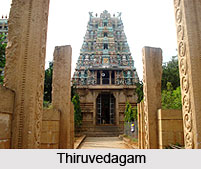 Thiruvadhavur
Thiruvadhavur
This place is situated about 9 kms from Melur near Madurai. This is the birthplace of one of the Saivaite saint Manickavasagar. He was the minister to a Pandya king. It is said that he built a temple for Siva with the money he was entrusted to buy horses for the king. Later, Lord Siva performed a miracle by which foxes were transformed into horses. These were taken by the king and sent to the stables, where they again turned into foxes. The site of the house of his birth is pointed out to visitors.
Madappuram Badrakali Amman Temple
Madappuram Badrakali Amman Temple is a famous temple of Tamil Nadu. It is situated at Madappuram about 20 kms from Madurai near Thiruppuvanam. Many V.I.Ps, cine stars and I.A.S. officers often visit this temple. It stands on the banks of the river Vaigai on the northern side of Esanar Koil.
This Badrakali Amman Temple is situated amidst a cool coconut grove. The first idols that greet the visitor here are that of Lord Ayyanar and of his horse. The idol of the horse has protruding teeth and bulging eyes and Lord Ayyanar is shown with a fierce look. These two together really make the visitors tremble in fright. The height of the horse is 30 ft, which wears a garland of lemons.
A large number of devotees pray to the Goddess, the presiding deity of this temple, for creative comforts, promotions in job and for the ruin of their enemies. There is a peculiar practice in this Badrakali Amman temple as per which a coin is cut and it is offered to the deity to get relief from being bullied by the mighty. A gunny bag full of cut coins is therefore seen here.
Vaigai Dam
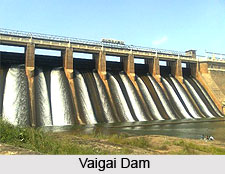 This dam is situated across the river Vaigai is 69 kms from Madurai. This was constructed to enhance the water supply. The height of this dam is 106 ft and its breadth is 11,657 ft. Its capacity is 58,000 cubic ft. It irrigates several hectares of land. A beautifully decorated garden can be seen here. It is a well known picnic spot.
This dam is situated across the river Vaigai is 69 kms from Madurai. This was constructed to enhance the water supply. The height of this dam is 106 ft and its breadth is 11,657 ft. Its capacity is 58,000 cubic ft. It irrigates several hectares of land. A beautifully decorated garden can be seen here. It is a well known picnic spot.
Cumbum Valley
It is located in the newly formed Theni district. One can reach easily here from Madurai. It has beautiful scenic spots like Kandamanur, Kadamalai Kundu, Mayiladumparai and various streams like Varaha Nadhi, Mullaiyar etc. It also possesses various hills and estates. The Suruli Falls and Thekkady on the verge of Kerala are the chief attractions here.
Suruli Falls
It is situated 128 kms from Madurai on the way to Thekkadi. Pilgrims visit this sacred spot on specific days. Nowadays, it has become a popular picnic spot. The tourists can have a soothing bath under this fall. There is a rope rail from Suruli dam to Moonaru for about 50 kms distance for the quick transport of tealeaves from the estates.
Periar Wildlife Sanctuary
This sanctuary is on the verge of Kerala about 155 kms from Madurai. It lies between Tamil Nadu and Kerala. It covers an area of about 729.29 sq.km. Those who want to see the animals can go by a motor boat along the Periar Lake and watch them on the hills surrounding the lake. The animals can be seen, who come to drink water at various places.
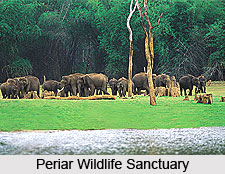 One can also hire boats from which the animals can be seen in their natural habitat basking in the sun, adult elephant helping elephant calves to climb the slopes, bathing in the water, preying, frolicking etc. The lucky tourists can have the glimpses of the tigers, elephants, bisons, deers and boars. The elephant herd with elephants of all sizes is one of the most common sights here.
One can also hire boats from which the animals can be seen in their natural habitat basking in the sun, adult elephant helping elephant calves to climb the slopes, bathing in the water, preying, frolicking etc. The lucky tourists can have the glimpses of the tigers, elephants, bisons, deers and boars. The elephant herd with elephants of all sizes is one of the most common sights here.
The fragrance of cardamom and other spices emanating from the estates around can be felt when the visitors enter Kumizhi. It is the border line and from there Thekkady can be reached by a short walk amidst sylvan surroundings.
All these places can be reached by buses from Madurai.
